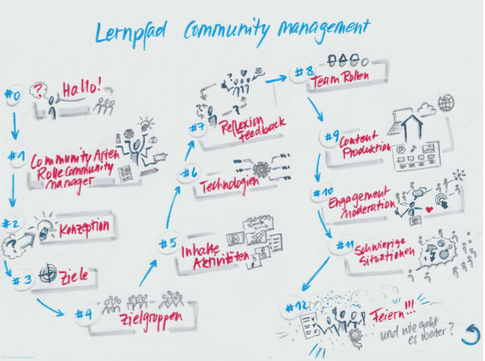Nowadays, networks and communities are not just about social interaction. Communities are primarily about creating value – across a very broad spectrum.
Achim Brück – Mercedes-Benz AG, Harald Lauritsch – Siemens Healthineers, Katharina Lobeck – Deutsche Gesellschaft für internationale Zusammenarbeit (GIZ), Stefanie Suarez (Preisinger) – Continental, Alfred Zedelmaier – Audi AG and I have jointly developed and relaunched the lernOS Community Management Guide. It serves as an aid for community managers to set up and develop their own internal communities.
What exactly the lernOS Community Management Guide contains and what it is suitable for is presented in detail below.
What is lernOS?
lernOS is an open learning format for individuals and companies to jointly address constant change and lifelong learning. Using a learning path, topics of all kinds can be worked on individually or together in groups. More information can be found on this page: lernOS – Keep Calm & Learn On
The lernOS Community Management Guide is a method for self-organization, which contributes to a successful way of working in community management through continuous learning and development. With all the changing challenges of today.
Specifically, the guide is a digital format in which participants learn step by step how to successfully organize their work and themselves and thus advance their community project.
In order to meet the individual needs of the community managers who complete the lernOS guide as meaningfully as possible, it consists of two parts:

The first part offers the theoretical basics and background: Here, participants can read up at their leisure and gain an overview of the most important and upcoming topics. The focus here is on independent information gathering as needed.

The second part includes the learning path. Here we pick up on community management and run through various topic sections for 12 weeks. The focus is on practice: participants are given a task to be completed practically within their community. At the weekly meetings, the experiences and successes from these to-dos, as well as general progress in the respective communities, are then shared with the learning group and discussed. In the process, commonalities can often be found, but also new learnings.

In both parts, case studies from the community are meant to inspire and also help.
Through these two components, we want to pick up each participant and support them as effectively as possible. In terms of methodology, we rely on a colorful mix of
- theoretical learning content,
- best practice collections,
- activity catalogs with inspiration
- as well as so-called strategy cocktails for the development of suitable actions depending on the objective.
Organizationally, the contents are arranged in such a way that the different chapters refer to each other and a flexible entry at different points in the guide is possible at any time.
How can lernOS help you build and develop your community?
Although the contents of the lernOS Community Management Guide can be used elsewhere and adapted to specific situations, internal community managers are the main target group. In other words, people who take care of the needs of internal communities. Internal communities are those that are directed inwards to the employees of an organization and not outwards to customers, interested parties and partners.
The main tasks of managing such communities are to develop an appropriate strategy, to network and activate employees, and to communicate with the target group.
The goal is to reach the employees of the organization. To network with each other in order to find synergies and to use them actively.
Especially in large corporations, knowledge and experience can quickly be lost if the content is not communicated across departments. A community can be very helpful here, promoting communication within the company and structuring it at the same time. Suitable and trained community managers can extract important content from the free exchange and derive important actions for the company from it.
Another important task is to strengthen the promotion of the community within the various departments as well as across locations within the company group. As many and as varied employees as possible should be activated and get involved in discussions relevant to the company. Community managers act as contact persons for members on a wide range of issues. They are available at all times to share their expertise.
The focus of internal communities is always on the goals of the company. Community management should support this and actively break down internal barriers to improve the flow of knowledge. The community is a safe place where comments can be made freely and feedback can be communicated openly and honestly.
Employees are motivated by the interaction in a community: Employees use the platform for networking, their identification with the employer is strengthened and they work longer for the organization.
The lernOS Community Management Guide helps companies to improve internal communication, increase employee motivation and better understand their own internal potential.
The contents of lernOS at a glance
The lernOS Community Management Guide consists of the two parts „Basics“ and „Learning Path“.
Basics
In the first part a lot of information can be found, which can be accessed independently. After a short introduction to the topic and important information about the guide, participants learn a lot about community management.
To get started with the topic, we offer a short excursus that deals with structures and organizational models. This chapter also explains what communities are and how they can be set up. Here we have also paid attention to the use of technical terms and their explanation in order to counteract possible ambiguities in the later learning flow and language use.
In addition to these initial explanations, the various community types and roles are also presented in detail: For example, readers learn what a community of interest is according to Richard Millington or a network according to Etienne Wenger and Beverly Trayner.
With the help of the overview of the different community roles and their characteristics, guide users can assign themselves and other people within the community to these roles. In this way, a better understanding of individual groupings within the community can be developed.
In particular, we have highlighted the role of community managers. Since the target group of the guide consists mainly of employees in these positions. Requirements and the importance of the community manager have been elaborated in more detail. This enables readers to access a great deal of important information at the outset and to filter out the knowledge that is relevant to them.
In order to understand how a community comes into being and develops, a description of the community lifecycle follows. It becomes clear how a community lives and that even seemingly negative phases are important for driving change and long-term growth.
In order to show practical applications and examples, various community case studies are presented. Internal initiatives such as those at Bosch or Continental act as best practices and show what is possible.
Strategic development
As the last major block of fundamentals, we offer input on the establishment, management and further development of communities. Here, a wide variety of topics are covered, from conception to concrete recommendations for action.
The cornerstone of community organization is self-explanatory: The development of a community begins with a group of people who are interested in the same topic or who share a common goal. It should be noted that a finished strategy is by no means required, but that the community should start before it is even ready. Different opinions and feedback on plans are very important in the start-up phase, which is why a „jump into the deep end“ can be worthwhile.
As soon as the first participants have come together, a concrete concept can be started. As tools, we recommend the Community Canvas Model and the Community Party List. Both tools are explained in more detail in the guide. References to implementation aids are also mentioned.
Ultimately, we would like to use this section to support community managers in finding and maintaining a common thread for community building. In this step, we also want to clarify the objectives and the importance of the community: The question of resources or allies is the focus here.
Once a roadmap for implementation is in place, the actual community work begins. A topic and activity plan can be supportive at this point. The success of community development should be measured and reviewed at regular intervals. In this way, adjustments can be made if necessary. Various strategies should serve as impulses for community managers and show them how changes can be developed and implemented.
The concrete implementation
Once the initial planning process has been completed and the concept for the community has been established, the next step is implementation. In order to grow the community and reach additional members, it must be actively promoted. Channels that the target group uses regularly should be chosen for this purpose. New participants are also important: Community managers can address them directly and point out the community, its activities and its benefits.
As soon as a new community member has been recruited, activation begins: Here it is the task of community managers to accept new members from day one. The earlier and better the integration takes place, the more active they will be in the community in the future. Community managers act as „hosts“ in this process.
Community managers also ensure that rules are adhered to, thus creating an appreciative atmosphere in a protected space. Activities such as blog parades or Working out Loud are also explained in this section of the lernOS Community Management Guide.
In order to not only promote exchange and togetherness, but also to be able to work together on something and create content, it is important to set up a suitable environment. This can be based on internal company regulations or tools.
In addition to the exchange among each other, community events are also an essential part of community development. It is all about the mix: The introduction of new members or networking in a relaxed atmosphere should not be missing. After all, a diverse range of events can both achieve strategic goals and strengthen personal relationships.
When community managers end communities, they have often achieved their goal. The completion of work for which the community was brought together can be one of many reasons. It is one of the tasks of community managers to keep an eye on this issue.
At least once a year, it should be checked whether the community is still serving its purpose. Has the community goal been achieved? Do community members still use the platform or do they devote themselves to other topics?
A community that remains active can continue to exist. After all, social contacts and networking are often profitable for companies even after a topic has been completed.
The second part of the lernOS guide: The learning path
The learning path is the second part of the lernOS Community Management Guide. It mainly contains practical tasks. Users can complete the learning path after the basics or start with the learning path and read the individual chapters one by one. The path can be worked on according to one’s own ideas and preferences – different learning types will find suitable content and tasks.
In 12 weeks, (prospective) community managers can build their own community thanks to the learning path. They are given the right tools for the job. In addition to the basics, various topics are taught in the form of thought-provoking ideas, questions and practical tasks. In this way, participants can pick out the aspects that are relevant to them and look up detailed explanations. Reflection is also a to-do in each week – it is important for community managers to look at their progress to date and make improvements where necessary.

An important point in the learning path is therefore also the mid-term reflection: This includes surveying stakeholders or other relevant target groups. With the help of the feedback, it is then easier to define the next strategic steps.
Another important point on the learning path is: Celebrate! Community managers are also allowed to enjoy their work – they should celebrate themselves and their successes. Celebrating the successful development of a community is therefore the final task of the learning path. 🎉
The appendix of the lernOS guide
The appendix contains additional sources and references as well as links to further reading. In addition to the classics, the recommended readings include a number of current titles. It is also worth taking a look at the lernOS website, the lernOS community with access to resources and a community of learning enthusiasts.
In addition to the online version, the guide can also be downloaded in various formats, for example as an e-book. All lernOS guides are usable under Creative Commons Attribution 4.0 International (CC BY 4.0).
For a further overview of how to set up and work with the lernOS guide, see this LinkedIn post by Achim Brück: How does community work? – Getting started with the new lernOS Community Management Guide
Conclusion: For whom is the lernOS guide worth a look?
We are convinced of our free guide and have jointly contributed our know-how to make it as easy as possible for future community managers.
The feedback is consistently positive and our guide offers a lot of information that can help many people in the community sector – maybe you too!
We are very happy about new enthusiastic readers from our network, about constructive criticism to our contents. We are always looking for participants who would like to contribute their own knowledge and help with the next revision. So please feel free to contact me or the other authors directly.
We presented the lernOS guide at the lernOS convention and discussed practical examples and extensions with the community managers from various companies who were present: Let’s talk Communities: Experiences and trends around internal communities.
The complete guide can be downloaded here: lernOS Community Management
At the moment the guide is only available in German, but there will be an English version soon.



